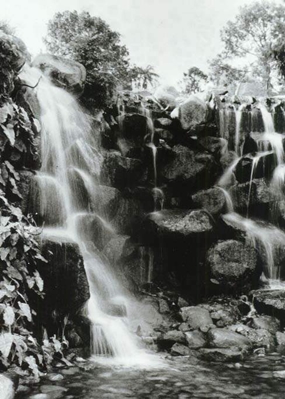There is a very unfortunate (and expensive) collective thought in the camera owning fraternity that to improve your shots you should move up to expensive camera bodies, extra lenses, 12 zillion pixels and then select “Great Shots” on the Auto mode button. However, there is no camera made with an uploaded software package to ensure “great shots” every time. “Great shots” are under your command, not in the “Auto” setting on your camera.
An example of where the “Auto” setting can be at odds with what the photographer wanted was brought home some time ago when a gentleman wrote it with the following letter.
“Dear Harry,
A question for you regarding some disappointment. I recently was a guest at a beautiful wedding, the reception was quite well lit so I thought rather than use a flash and have everybody look like ghosts I would turn the flash off.
 Slow shutter speed with tripod.
Slow shutter speed with tripod.
What I had not taken into consideration was that the shutter speed would be slower without the flash. Most of the photos were blurred, either by me shaking, or the people I was photographing moving during the shot.
At least I am assuming that was the cause of the bad shots, what is your opinion Harry?
Thanking you, Sunny,
Your assumption was spot on. The clever brain (or electronic smarts) inside the camera knows that a certain Exposure Value (EV) is required to produce correctly exposed shots. That EV has two variables, but which are related directly to each other, and they are the size of the aperture and shutter speed.
Now even though you felt the venue was well lit, and I do often tell people to turn off the flash to stop the rabbit in the headlamps look, that venue’s ambient lighting was not enough to get to the EV required without some extreme values in aperture and shutter speed.
I will presume that you had the camera on full ‘auto’ and not on Aperture Priority, but the result would have been around the same. The electronic brain knows you can’t hand-hold at much slower than 1/30th second so will try to use that shutter speed and open up the aperture to whatever is needed to get the correct EV. That’s the theory.
However, when the camera runs out of aperture setting, then all that is left for the camera brain to do is to adjust is the shutter speed even further and its little electronic brain gives the camera an even slower shutter speed, at which you cannot hand-hold. Blurred shots are the result.”
So the first simple way to improve your shots, is to still turn off the flash in low light situations, but use a tripod to keep the camera still. I carry a very small fold-up tripod which can sit on a table, on the floor, or anywhere you can accommodate its three legs. Be careful when you depress the shutter button that you don’t move the camera on the tripod, or the tripod itself, or you have defeated the purpose in having a tripod.
The next way to add some of that elusive “greatness” to your photographs is to remember and adhere to, the Rule of Thirds.
Simply, all this means is to make sure the subject is one third in from either edge of the viewfinder. Just by placing your subject off-center immediately drags your shot out of the “ordinary” basket. The technocrats call this the “Rule of Thirds”, but just try putting the subjects off-center. While still on the Rule of Thirds, don’t have the horizon slap bang in the center of the picture either. Put it one third from the top or one third from the bottom. As a rough rule of thumb, if the sky is interesting put more of it in the picture, but if it is featureless blue or grey include less of it. Simple!
The next item to be aware of is to make the subject the “hero”. This just means that when you look at the photo, the subject leaps out of the picture as obviously the “hero”. You do this by walking several meters closer and making the subject fill the frame. Try it. It works!




